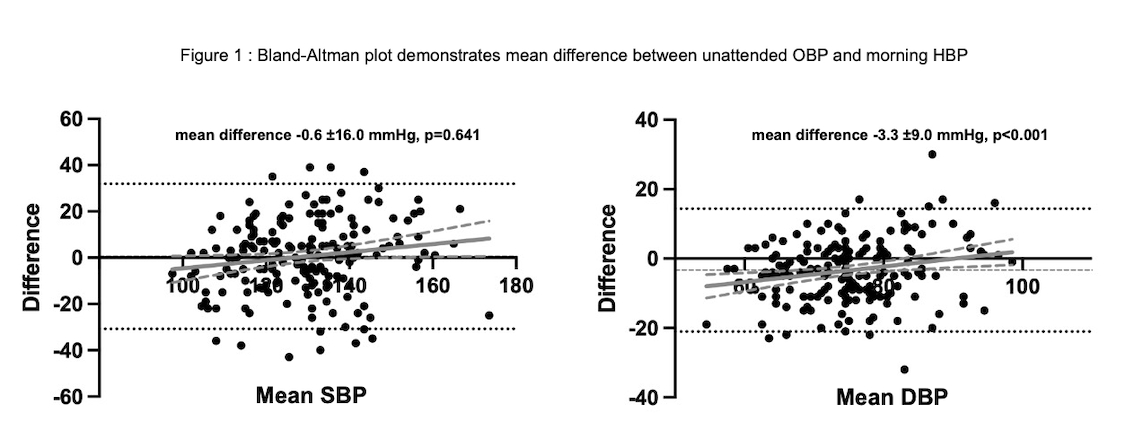Final ID: 50
The Comparison of Office Blood Pressure with Morning Home Blood Pressure: Self-Automated Measurement
Abstract Body: Background: Morning hypertension is associated with poor cardiovascular outcomes. However, office blood pressure (OBP) remains a gold standard in hypertension monitoring and management. Unfortunately, the accuracy in OBP measurement is problematic.
Objectives: This study aimed to determine whether routine or unattended OBP could accurately represent home blood pressure (HBP) in patients with hypertension.
Methods: We conducted a single-center, cross-sectional study. Hypertensive patients aged between 18 and 80 years, capable of performing self-automated blood pressure measurement, were included in the study. Three self-automated methods of blood pressure measurement were performed: Routine OBP, unattended OBP, and HBP. All participants were instructed to rest for at least 5 minutes prior to measuring blood pressure, and HBP was recorded twice daily, in the morning and at night, for a week after the enrolled visit without antihypertensive medication adjustment.
Results: Overall 190 consecutive patients were enrolled, with a mean age of 65.2 ±7.5 years old. Half of the patients had coronary artery disease or type 2 diabetes as comorbidities. Routine OBP was significantly higher than unattended OBP and HBP. Interestingly, Systolic values of unattended OBP were similar to those of morning HBP (mean difference -0.6 ±16.0 mmHg, p=0.641) with moderate correlation (r=0.516, p<0.001). Although diastolic values of unattended OBP were lower than those of morning HBP (mean difference -3.3 ±9.0 mmHg, p<0.001), the values were moderately correlated (r=0.581, p<0.001). Bland-Alman plots between unattended OBP and morning HBP were shown in Figure 1. Both systolic and diastolic values of unattended OBP and average HBP were significantly different (mean difference -3.5 ±14.9 mmHg, p=0.002, and 1.6 ±8.6 mmHg, p=0.013, respectively).
Conclusion: Unattended OBP method could effectively represent morning HBP, thus advocating to use in clinical practice.
Objectives: This study aimed to determine whether routine or unattended OBP could accurately represent home blood pressure (HBP) in patients with hypertension.
Methods: We conducted a single-center, cross-sectional study. Hypertensive patients aged between 18 and 80 years, capable of performing self-automated blood pressure measurement, were included in the study. Three self-automated methods of blood pressure measurement were performed: Routine OBP, unattended OBP, and HBP. All participants were instructed to rest for at least 5 minutes prior to measuring blood pressure, and HBP was recorded twice daily, in the morning and at night, for a week after the enrolled visit without antihypertensive medication adjustment.
Results: Overall 190 consecutive patients were enrolled, with a mean age of 65.2 ±7.5 years old. Half of the patients had coronary artery disease or type 2 diabetes as comorbidities. Routine OBP was significantly higher than unattended OBP and HBP. Interestingly, Systolic values of unattended OBP were similar to those of morning HBP (mean difference -0.6 ±16.0 mmHg, p=0.641) with moderate correlation (r=0.516, p<0.001). Although diastolic values of unattended OBP were lower than those of morning HBP (mean difference -3.3 ±9.0 mmHg, p<0.001), the values were moderately correlated (r=0.581, p<0.001). Bland-Alman plots between unattended OBP and morning HBP were shown in Figure 1. Both systolic and diastolic values of unattended OBP and average HBP were significantly different (mean difference -3.5 ±14.9 mmHg, p=0.002, and 1.6 ±8.6 mmHg, p=0.013, respectively).
Conclusion: Unattended OBP method could effectively represent morning HBP, thus advocating to use in clinical practice.
More abstracts on this topic:
A durable reduction in blood pressure by ultrasound renal denervation: A real-world, single center experience
King Jordan, Gharib Wissam
A closed-loop system based on piezoelectric thin-film sensors and photothermal nanomaterials enables precise renal denervation for the treatment of hypertensionLiu Chengzhe, Zhou Liping, Yu Lilei

